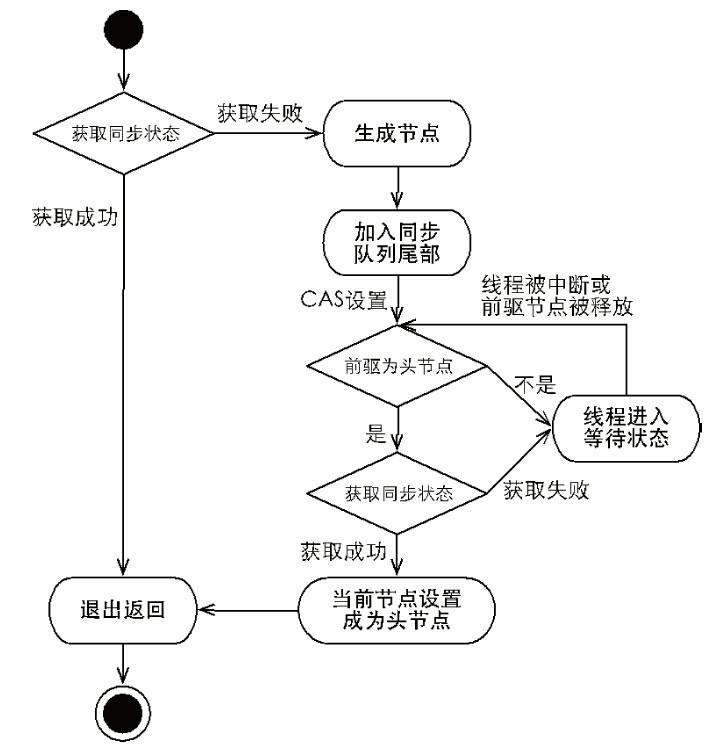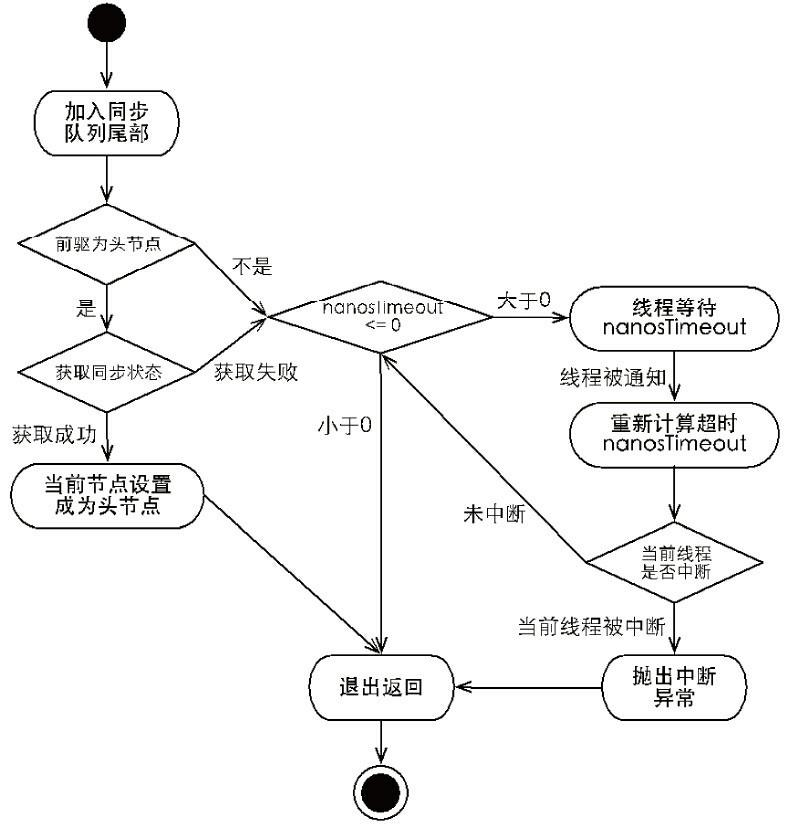AQS:Java 中悲觀鎖的底層實現機制
介紹 AQS
AQS(AbstractQueuedSynchronizer)是 Java 並行包中,實現各種同步元件的基礎。比如
- 各種鎖:ReentrantLock、ReadWriteLock、StampedLock
- 各種執行緒同步工具類:CountDownLatch、CyclicBarrier、Semaphore
- 執行緒池中的 Worker
Lock 介面的實現基本都是通過聚合了一個 AQS 的子類來完成執行緒存取控制的。
Doug Lea 曾經介紹過 AQS 的設計初衷。從原理上,一種同步元件往往是可以利用其他的元件實現的,例如可以使用 Semaphore 實現互斥鎖。但是,對某種同步元件的傾向,會導致複雜、晦澀的實現邏輯,所以,他選擇了將基礎的同步相關操作抽象在 AbstractQueuedSynchronizer 中,利用 AQS 為我們構建同步元件提供了範本。
如何使用 AQS
利用 AQS 實現一個同步元件,我們至少要實現兩類基本的方法,分別是:
- 獲取資源,需要實現 tryAcquire(int arg) 方法
- 釋放資源,需要實現 tryRelease(int arg) 方法
如果需要共用式獲取 / 釋放資源,需要實現對應的 tryAcquireShared(int arg)、tryReleaseShared(int arg)
AQS 使用的是模板方法設計模式。AQS 方法的修飾符很有規律,其中,使用 protected 修飾的方法為抽象方法,通常需要子類去實現,從而實現不同的同步元件;使用 public 修飾的方法基本可以認為是模板方法,不建議子類直接覆蓋。
通過呼叫 AQS 的 acquire(int arg) 方法可以獲取資源,該方法會呼叫 protected 修飾的 tryAcquire(int arg) 方法,因此我們需要在 AQS 的子類中實現 tryAcquire(int arg),tryAcquire(int arg) 方法的作用是:獲取資源。
當前執行緒獲取資源並執行了相應邏輯之後,就需要釋放資源,使得後續節點能夠繼續獲取資源。通過呼叫 AQS 的 release(int arg) 方法可以釋放資源,該方法會呼叫 protected 修飾的 tryRelease(int arg) 方法,因此我們需要在 AQS 的子類中實現 tryRelease(int arg),tryRelease(int arg) 方法的作用是:釋放資源。
AQS 的實現原理
從實現角度分析 AQS 是如何完成執行緒存取控制。
AQS 的實現原理可以從 同步阻塞佇列、獲取資源時的執行流程、釋放資源時的執行流程 這 3 個方面介紹。
同步阻塞佇列
AQS 依賴內部的同步阻塞佇列(一個 FIFO 雙向佇列)來完成資源的管理。
同步阻塞佇列的工作機制:
- 節點:同步阻塞佇列中的節點(Node)用來儲存獲取資源失敗的執行緒參照、等待狀態以及前驅和後繼節點,沒有成功獲取資源的執行緒將會成為節點加入同步阻塞佇列的尾部,同時會阻塞當前執行緒(Java 執行緒處於 WAITING 狀態,釋放 CPU 的使用權)。
- 首節點:同步阻塞佇列遵循 FIFO(先進先出),首節點是獲取資源成功的節點,首節點的執行緒在釋放資源時,將會喚醒後繼節點,使其再次嘗試獲取資源,而後繼節點將會在獲取資源成功時將自己設定為首節點。
static final class Node {
/**
* Marker to indicate a node is waiting in shared mode
*/
static final AbstractQueuedSynchronizer.Node SHARED = new AbstractQueuedSynchronizer.Node();
/**
* Marker to indicate a node is waiting in exclusive mode
*/
static final AbstractQueuedSynchronizer.Node EXCLUSIVE = null;
/**
* waitStatus value to indicate thread has cancelled
*/
static final int CANCELLED = 1;
/**
* waitStatus value to indicate successor's thread needs unparking
*/
static final int SIGNAL = -1;
/**
* waitStatus value to indicate thread is waiting on condition
*/
static final int CONDITION = -2;
/**
* waitStatus value to indicate the next acquireShared should
* unconditionally propagate
*/
static final int PROPAGATE = -3;
// 等待狀態
volatile int waitStatus;
// 前驅節點
volatile AbstractQueuedSynchronizer.Node prev;
// 後繼節點
volatile AbstractQueuedSynchronizer.Node next;
/**
* The thread that enqueued this node. Initialized on
* construction and nulled out after use.
*/
volatile Thread thread;
// 條件等待佇列的後繼節點
AbstractQueuedSynchronizer.Node nextWaiter;
/**
* Returns true if node is waiting in shared mode.
*/
final boolean isShared() {
return nextWaiter == SHARED;
}
/**
* Returns previous node, or throws NullPointerException if null.
* Use when predecessor cannot be null. The null check could
* be elided, but is present to help the VM.
*
* @return the predecessor of this node
*/
final AbstractQueuedSynchronizer.Node predecessor() throws NullPointerException {
AbstractQueuedSynchronizer.Node p = prev;
if (p == null) throw new NullPointerException();
else return p;
}
Node() { // Used to establish initial head or SHARED marker
}
Node(Thread thread, AbstractQueuedSynchronizer.Node mode) { // Used by addWaiter
this.nextWaiter = mode;
this.thread = thread;
}
Node(Thread thread, int waitStatus) { // Used by Condition
this.waitStatus = waitStatus;
this.thread = thread;
}
}
等待狀態
在節點中用 volatile int waitStatus 屬性表示節點的等待狀態。
節點有如下幾種等待狀態:
- CANCELLED,值為 1,由於在同步阻塞佇列中等待的執行緒等待超時或者被中斷,需要從同步阻塞佇列中取消等待,節點進人該狀態將不會變化
- SIGNAL,值為 -1,後繼節點的執行緒處於等待狀態,而當前節點的執行緒如果釋放了同步狀態或者被取消,將會通知後繼節點,使後繼節點的執行緒得以執行
- CONDITION,值為 -2,節點在條件等待佇列中,節點執行緒等待在 Condition 上,當其他執行緒對Condition 呼叫了 signal() 方法後,該節點將會從條件等待佇列轉移到同步阻塞佇列中,加入到對同步狀態的獲取中
- PROPAGATE,值為 -3,表示下一次共用式同步狀態獲取將會無條件地被傳播下去
- INITIAL,值為 0,初始狀態
獲取資源、釋放資源的執行流程,結論先行:
- 在獲取資源時,獲取資源失敗的執行緒都會被加入到同步阻塞佇列中,並在佇列中進行自旋;移出佇列(或停止自旋)的條件是前驅節點為頭節點且成功獲取了資源。
- 在釋放資源時,AQS 呼叫 tryRelease(int arg) 方法釋放資源,然後喚醒頭節點的後繼節點。
獲取資源
下面來介紹獲取資源時的執行流程。
呼叫 AQS 的 acquire(int arg) 方法可以獲取資源。
acquire(int arg) 方法是獨佔式獲取資源,它呼叫流程如下圖所示。

用文字描述 acquire(int arg) 方法的呼叫流程:首先呼叫自定義 AQS 實現的 tryAcquire(int arg) 方法,該方法的作用是嘗試獲取資源:
-
如果獲取資源成功,則直接從 acquire(int arg) 方法返回
-
如果獲取資源失敗,則構造節點,並將該節點加入到同步阻塞佇列的尾部,最後呼叫 acquireQueued(Node node,int arg) 方法,使得該節點以「死迴圈」的方式嘗試獲取資源。只有當前節點的前驅節點是頭節點,才能嘗試獲取資源。
-
- 如果當前節點的前驅節點是頭節點,並且獲取資源成功,則設定當前節點為頭節點,並從 acquireQueued(Node node,int arg) 方法返回
- 如果當前節點的前驅節點不是頭節點 或者 獲取資源失敗,則阻塞當前執行緒,執行緒被喚醒後繼續執行該回圈操作
acquireQueued(Node node,int arg) 方法的呼叫過程也被稱為「自旋過程」。
自旋是什麼意思是呢?我的理解就是:自旋就是一個死迴圈,迴圈執行某個操作序列,直到滿足某個條件才退出迴圈。
/**
* Acquires in exclusive mode, ignoring interrupts. Implemented
* by invoking at least once {@link #tryAcquire},
* returning on success. Otherwise the thread is queued, possibly
* repeatedly blocking and unblocking, invoking {@link
* #tryAcquire} until success. This method can be used
* to implement method {@link Lock#lock}.
*
* @param arg the acquire argument. This value is conveyed to
* {@link #tryAcquire} but is otherwise uninterpreted and
* can represent anything you like.
*/
public final void acquire(int arg) {
if (!tryAcquire(arg) && acquireQueued(addWaiter(Node.EXCLUSIVE), arg))
selfInterrupt();
}
acquire(int arg) 的主要邏輯是:
首先呼叫自定義 AQS 實現的 tryAcquire(int arg) 方法,該方法保證執行緒安全的獲取資源:
- 如果獲取資源成功,則直接從 acquire(int arg) 方法返回
- 如果獲取資源失敗,則構造同步節點(獨佔式 Node.EXCLUSIVE,同一時刻只能有一個執行緒成功獲取資源)並通過 addWaiter(Node node) 方法將該節點加入到同步阻塞佇列的尾部,最後呼叫 acquireQueued(Node node,int arg) 方法,使得該節點以「死迴圈」的方式獲取資源。如果獲取不到則阻塞節點中的執行緒,而被阻塞執行緒的喚醒主要依靠 前驅節點的出隊 或 阻塞執行緒被中斷 來實現。
/**
* Acquires in exclusive uninterruptible mode for thread already in
* queue. Used by condition wait methods as well as acquire.
*
* @param node the node
* @param arg the acquire argument
* @return {@code true} if interrupted while waiting
*/
final boolean acquireQueued(final Node node, int arg) {
boolean failed = true;
try {
boolean interrupted = false;
for (;;) {
final Node p = node.predecessor();
if (p == head && tryAcquire(arg)) {
setHead(node);
p.next = null; // help GC
failed = false;
return interrupted;
}
if (shouldParkAfterFailedAcquire(p, node) &&
parkAndCheckInterrupt())
interrupted = true;
}
} finally {
if (failed)
cancelAcquire(node);
}
}
在 acquireQueued(final Node node,int arg) 方法中,當前執行緒在「死迴圈」中嘗試獲取資源,而只有前驅節點是頭節點才能夠嘗試獲取資源,這是為什麼?原因有兩個,如下。
- 第一,頭節點是成功獲取到資源的節點,而頭節點的執行緒釋放了資源之後,將會喚醒其後繼節點,後繼節點的執行緒被喚醒後需要檢查自己的前驅節點是否是頭節點。
- 第二,維護同步阻塞佇列的 FIFO 原則。
釋放資源
當前執行緒獲取資源並執行了相應邏輯之後,就需要釋放資源,使得後續節點能夠繼續獲取資源。
下面來介紹釋放資源時的執行流程。
通過呼叫 AQS 的 release(int arg) 方法可以釋放資源,該方法在釋放資源之後,會喚醒頭節點的後繼節點,進而使後繼節點重新嘗試獲取資源。
/**
* Releases in exclusive mode. Implemented by unblocking one or
* more threads if {@link #tryRelease} returns true.
* This method can be used to implement method {@link Lock#unlock}.
*
* @param arg the release argument. This value is conveyed to
* {@link #tryRelease} but is otherwise uninterpreted and
* can represent anything you like.
* @return the value returned from {@link #tryRelease}
*/
public final boolean release(int arg) {
if (tryRelease(arg)) {
Node h = head;
if (h != null && h.waitStatus != 0)
unparkSuccessor(h);
return true;
}
return false;
}
release(int arg) 方法執行時,會喚醒頭節點的後繼節點執行緒, unparkSuccessor(Node node) 方法使用 LockSupport#unpark() 方法來喚醒處於等待狀態的執行緒。
共用式 獲取 & 釋放 資源
上面講的是獨佔式獲取 / 釋放 資源。
共用式獲取與獨佔式獲取最主要的區別在於:同一時刻能否有多個執行緒同時獲取到資源。以檔案的讀寫為例,如果一個程式在對檔案進行讀操作,那麼這一時刻對於該檔案的寫操作均被阻塞,而讀操作能夠同時進行。寫操作要求對資源的獨佔式存取,而讀操作可以是共用式存取。
- 共用式存取資源時,其他共用式的存取均被允許,獨佔式存取被阻塞
- 獨佔式存取資源時,同一時刻其他存取均被阻塞
共用式獲取資源
呼叫 AQS 的 acquireShared(int arg) 方法可以共用式地獲取資源。
在 acquireShared(int arg) 方法中,AQS 呼叫 tryAcquireShared(int arg) 方法嘗試獲取資源, tryAcquireShared(int arg) 方法返回值為 int 型別,當返回值 >= 0 時,表示能夠獲取到資源。
可以看到,在 doAcquireShared(int arg) 方法的自旋過程中,如果當前節點的前驅為頭節點時,才能嘗試獲取資源,如果獲取資源成功(返回值 >= 0),則設定當前節點為頭節點,並從自旋過程中退出。
public final void acquireShared(int arg) {
if (tryAcquireShared(arg) < 0)
doAcquireShared(arg);
}
private void doAcquireShared(int arg) {
final Node node = addWaiter(Node.SHARED);
boolean failed = true;
try {
boolean interrupted = false;
for (;;) {
final Node p = node.predecessor();
if (p == head) {
int r = tryAcquireShared(arg);
if (r >= 0) {
setHeadAndPropagate(node, r);
p.next = null; // help GC
if (interrupted)
selfInterrupt();
failed = false;
return;
}
}
if (shouldParkAfterFailedAcquire(p, node) &&
parkAndCheckInterrupt())
interrupted = true;
}
} finally {
if (failed)
cancelAcquire(node);
}
}
共用式釋放資源
呼叫 releaseShared(int arg) 方法可以釋放資源。該方法在釋放資源之後,會喚醒頭節點的後繼節點,進而使後繼節點重新嘗試獲取資源。
對於能夠支援多個執行緒同時存取的並行元件(比如 Semaphore),它和獨佔式主要區別在於 tryReleaseShared(int arg) 方法必須確保資源安全釋放,因為釋放資源的操作會同時來自多個執行緒。 確保資源安全釋放一般是通過迴圈和 CAS 來保證的。
public final boolean releaseShared(int arg) {
if (tryReleaseShared(arg)) {
doReleaseShared();
return true;
}
return false;
}
獨佔式超時獲取資源
呼叫 AQS 的 doAcquireNanos(int arg,long nanosTimeout) 方法可以超時獲取資源,即在指定的時間段內獲取資源,如果獲取資源成功則返回 true,否則返回 false。
該方法提供了傳統 Java 同步操作(比如 synchronized 關鍵字)所不具備的特性。
在分析該方法的實現前,先介紹一下響應中斷的獲取資源過程。
- 在 Java 5 之前,當一個執行緒獲取不到鎖而被阻塞在 synchronized 之外時,對該執行緒進行中斷操作,此時該執行緒的中斷標誌位會被修改,但執行緒依舊會阻塞在 synchronized 上,等待著獲取鎖。
- 在 Java 5 中,AQS 提供了 acquireInterruptibly(int arg) 方法,這個方法在等待獲取資源時,如果當前執行緒被中斷,會立刻返回,並丟擲 InterruptedException。
acquire(int arg) 方法對中斷不敏感,也就是由於執行緒獲取資源失敗後進入同步阻塞佇列中,後續對執行緒進行中斷操作時,執行緒不會從同步阻塞佇列中移出。
超時獲取資源過程可以被視作響應中斷獲取資源過程的「增強版」,doAcquireNanos(int arg,long nanosTimeout) 方法在支援響應中斷的基礎上,增加了超時獲取的特性。
針對超時獲取,主要需要計算出需要睡眠的時間間隔 nanosTimeout,為了防止過早通知, nanosTimeout 計算公式為:nanosTimeout -= now - lastTime,其中 now 為當前喚醒時間, lastTime 為上次喚醒時間,如果 nanosTimeout 大於 0 則表示超時時間未到,需要繼續睡眠 nanosTimeout 納秒,反之,表示已經超時。
public final boolean tryAcquireNanos(int arg, long nanosTimeout)
throws InterruptedException {
if (Thread.interrupted())
throw new InterruptedException();
return tryAcquire(arg) ||
doAcquireNanos(arg, nanosTimeout);
}
/**
* Acquires in exclusive timed mode.
*
* @param arg the acquire argument
* @param nanosTimeout max wait time
* @return {@code true} if acquired
*/
private boolean doAcquireNanos(int arg, long nanosTimeout) throws InterruptedException {
if (nanosTimeout <= 0L)
return false;
final long deadline = System.nanoTime() + nanosTimeout;
final Node node = addWaiter(Node.EXCLUSIVE);
boolean failed = true;
try {
for (;;) {
final Node p = node.predecessor();
if (p == head && tryAcquire(arg)) {
setHead(node);
p.next = null; // help GC
failed = false;
return true;
}
nanosTimeout = deadline - System.nanoTime();
if (nanosTimeout <= 0L)
return false;
if (shouldParkAfterFailedAcquire(p, node) &&
nanosTimeout > spinForTimeoutThreshold)
LockSupport.parkNanos(this, nanosTimeout);
if (Thread.interrupted())
throw new InterruptedException();
}
} finally {
if (failed)
cancelAcquire(node);
}
}
該方法在自旋過程中,當節點的前驅節點為頭節點時嘗試獲取資源,如果成功獲取資源則從該方法返回,這個過程和獨佔式同步獲取的過程類似,但是在獲取資源失敗的處理上有所不同。
如果當前執行緒獲取資源失敗,則判斷是否超時(nanosTimeout 小於等於 0 表示已經超時),如果沒有超時,則重新計算超時間隔 nanosTimeout,然後使當前執行緒等待 nanosTimeout 納秒(當已到設定的超時時間,該執行緒會從 LockSupport.parkNanos(Object blocker,long nanos)方法返回)。
如果 nanosTimeout 小於等於 spinForTimeoutThreshold(1000 納秒)時,將不會使該執行緒進行超時等待,而是進入快速的自旋過程。原因在於,非常短的超時等待無法做到十分精確,如果這時再進行超時等待,相反會讓 nanosTimeout 的超時從整體上表現得反而不精確。因此,在超時非常短的場景下,AQS 會進入無條件的快速自旋。
獨佔式超時獲取資源的流程如下所示。

從圖中可以看出,獨佔式超時獲取資源 doAcquireNanos(int arg,long nanosTimeout) 和獨佔式獲取資源 acquire(int args)在流程上非常相似,其主要區別在於:未獲取到資源時的處理邏輯。
acquire(int args) 在未獲取到資源時,將會使當前執行緒一直處於等待狀態,而 doAcquireNanos(int arg,long nanosTimeout) 會使當前執行緒等待 nanosTimeout 納秒,如果當前執行緒在 nanosTimeout 納秒內沒有獲取到資源,將會從等待邏輯中自動返回。
Condition 的實現原理
技術是為了解決問題而生的,通過 Condition 我們可以實現等待 / 通知功能。
ConditionObject 是 AQS 的內部類。每個 Condition 物件都包含著一個條件等待佇列,這個條件等待佇列是 Condition 物件實現等待 / 通知功能的關鍵。
下面我們分析 Condition 的實現原理,主要包括:條件等待佇列、等待 和 通知。
下面提到的 Condition 如果不加說明均指的是 ConditionObject。
條件等待佇列
Condition 依賴內部的條件等待佇列(一個 FIFO 雙向佇列)來實現等待 / 通知功能。
條件等待佇列的工作機制:
- 節點:條件等待佇列中的每個節點(Node)都包含一個執行緒參照,該執行緒就是在 Condition 物件上等待的執行緒,如果一個執行緒呼叫了 Condition.await()方法,那麼該執行緒將會釋放資源、構造成為節點加入條件等待佇列的尾部,同時執行緒狀態變為等待狀態。
事實上,條件等待佇列中的節點定義複用了 AQS 節點的定義,也就是說,同步阻塞佇列和條件等待佇列中節點型別都是 AQS 的靜態內部類 AbstractQueuedSynchronizer.Node。
在 Object 的監視器模型上,一個物件擁有一個同步阻塞佇列和一個條件等待佇列,而並行包中的 Lock(更確切地說是 AQS)擁有一個同步阻塞佇列和多個條件等待佇列。
等待
下面來介紹讓執行緒等待的執行流程。
呼叫 Condition 的 await() 方法(或者以 await 開頭的方法),將會使當前執行緒釋放資源、構造成為節點加入條件等待佇列的尾部,同時執行緒狀態變為等待狀態。
如果從佇列(同步阻塞佇列和條件等待佇列)的角度看 await()方法,當呼叫 await() 方法時,相當於同步阻塞佇列的首節點(獲取到鎖的節點)移動到 Condition 的條件等待佇列中。並且同步阻塞佇列的首節點並不會直接加入條件等待佇列,而是通過 addConditionWaiter() 方法把當前執行緒構造成一個新的節點,將其加入條件等待佇列中。
/**
* Implements interruptible condition wait.
* <ol>
* <li> If current thread is interrupted, throw InterruptedException.
* <li> Save lock state returned by {@link #getState}.
* <li> Invoke {@link #release} with saved state as argument,
* throwing IllegalMonitorStateException if it fails.
* <li> Block until signalled or interrupted.
* <li> Reacquire by invoking specialized version of
* {@link #acquire} with saved state as argument.
* <li> If interrupted while blocked in step 4, throw InterruptedException.
* </ol>
*/
public final void await() throws InterruptedException {
if (Thread.interrupted())
throw new InterruptedException();
Node node = addConditionWaiter();
int savedState = fullyRelease(node);
int interruptMode = 0;
while (!isOnSyncQueue(node)) {
LockSupport.park(this);
if ((interruptMode = checkInterruptWhileWaiting(node)) != 0)
break;
}
if (acquireQueued(node, savedState) && interruptMode != THROW_IE)
interruptMode = REINTERRUPT;
if (node.nextWaiter != null) // clean up if cancelled
unlinkCancelledWaiters();
if (interruptMode != 0)
reportInterruptAfterWait(interruptMode);
}
通知
下面來介紹喚醒等待執行緒的執行流程。
呼叫 Condition 的 signal() 方法,將會喚醒在條件等待佇列中等待時間最長的節點(首節點),在喚醒節點之前,會將當前節點從條件等待佇列移動到同步阻塞佇列中。
條件等待佇列中的節點被喚醒後,被喚醒的執行緒以「死迴圈」的方式嘗試獲取資源。成功獲取資源之後,被喚醒的執行緒將從先前呼叫的 await() 方法返回。
如果被喚醒的執行緒不是通過其他執行緒呼叫 Condition.signal() 方法喚醒,而是對等待執行緒進行中斷,則會丟擲InterruptedException。
被喚醒的執行緒,將從 await() 方法中的 while 迴圈中退出(isOnSyncQueue(Node node) 方法返回 true,節點已經在同步阻塞佇列中),進而呼叫 AQS 的 acquireQueued() 方法以「死迴圈」的方式嘗試獲取資源。成功獲取資源之後,被喚醒的執行緒將從先前呼叫的 await() 方法返回。
Condition 的 signalAll() 方法,相當於對條件等待佇列中的每個節點均執行一次 signal() 方法,效果就是將條件等待佇列中所有節點全部移動到同步阻塞佇列中,並喚醒每個節點的執行緒。
雖然是把每個節點的執行緒都喚醒了,這些執行緒需要嘗試獲取資源, 但是隻有一個執行緒能夠成功獲取資源,然後從 await() 方法返回;其他獲取資源失敗的執行緒又都會被加入到同步阻塞佇列中,並在佇列中進行自旋;移出佇列(或停止自旋)的條件是前驅節點為頭節點且成功獲取了資源。
/**
* Moves the longest-waiting thread, if one exists, from the
* wait queue for this condition to the wait queue for the
* owning lock.
*
* @throws IllegalMonitorStateException if {@link #isHeldExclusively}
* returns {@code false}
*/
public final void signal() {
if (!isHeldExclusively())
throw new IllegalMonitorStateException();
Node first = firstWaiter;
if (first != null)
doSignal(first);
}
/**
* Removes and transfers nodes until hit non-cancelled one or
* null. Split out from signal in part to encourage compilers
* to inline the case of no waiters.
* @param first (non-null) the first node on condition queue
*/
private void doSignal(Node first) {
do {
if ( (firstWaiter = first.nextWaiter) == null)
lastWaiter = null;
first.nextWaiter = null;
} while (!transferForSignal(first) &&
(first = firstWaiter) != null);
}
參考資料
《Java並行程式設計藝術》第5章:Java 中的鎖
本文來自部落格園,作者:真正的飛魚,轉載請註明原文連結:https://www.cnblogs.com/feiyu2/p/AQS.html